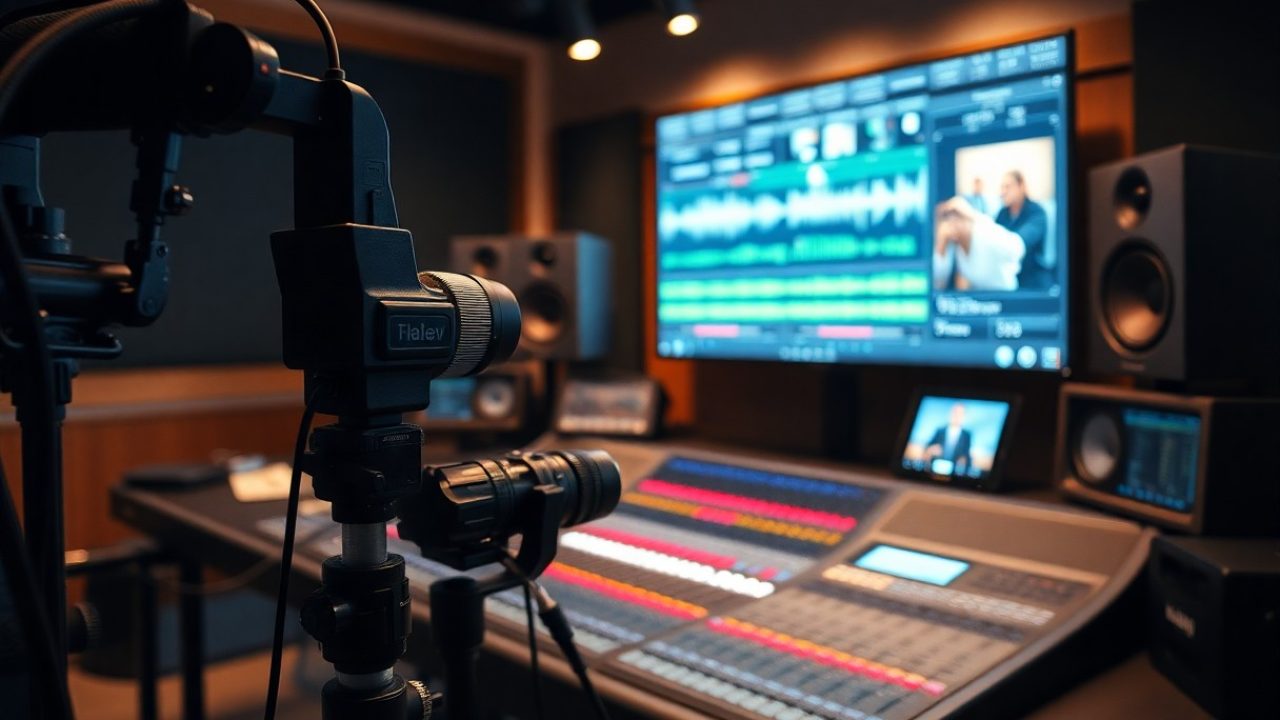Contents
There’s a growing demand for engaging audio and video information products, and mastering the art of production can set you apart in a crowded market. In this guide, you will discover necessary techniques and tools to create polished, professional content that captivates your audience. From scripting and recording to editing and distribution, you’ll learn how to elevate your production quality and effectively convey your message. Dive in and transform your ideas into compelling audio and video content that resonates with your viewers.
Key Takeaways:
- Invest in quality equipment and software to ensure professional audio and video production, enhancing the overall user experience.
- Plan your content carefully, including scripting and storyboarding, to maintain focus and streamline the editing process.
- Pay attention to post-production techniques, such as editing, mixing, and mastering, to deliver a polished final product that engages your audience.
Understanding High-Quality Audio and Video
To create content that captivates your audience, it’s necessary to understand the principles of high-quality audio and video production. Quality significantly impacts the viewer’s experience and can determine the success of your information products. From clarity and balance in audio to crisp visuals and effective lighting, grasping these elements will elevate your content and retain your audience’s attention.
Key Factors Influencing Quality
Audio and video quality is influenced by several key factors. Achieving excellence requires attention to:
- Recording environment
- Microphone selection
- Camera quality
- Lighting setup
- Post-production techniques
Thou must consider these factors thoughtfully to enhance the overall quality of your production.
Essential Equipment Choices
Factors that contribute to high-quality audio and video will largely depend on your equipment selections. Investing in the right tools is necessary for producing professional-grade content. This might include high-quality microphones, cameras, and lighting that fit your specific needs. Additionally, using software for editing can significantly improve the final product, ensuring clarity and polish. When you prioritize the details in your equipment choices, you lay a strong foundation for creating impactful visual and auditory experiences.
Influencing your production quality involves selecting equipment that aligns with your project’s goals and budget. For audio, consider condenser microphones for vocal clarity and dynamic options for versatility. For video, a camera with good resolution and lens options allows for creative framing and focus. Furthermore, proper lighting can elevate even the simplest setups. By tailoring your equipment choices, you can create an effective and captivating product that resonates with your audience.
Planning Your Content
You should begin your journey by planning your content meticulously. Define the purpose of your audio and video information products, and map out the key topics you want to cover. Establish a clear structure that guides your production process and helps streamline your workflow. For additional insights, check out Video Content Creation: Secrets to Producing High-Quality Videos.
Defining Your Target Audience
The first step in creating engaging content is to define your target audience. Understand their preferences, pain points, and needs, allowing you to tailor your message effectively. Knowing your audience will enable you to create relevant content that resonates and engages.
Structuring Engaging Scripts
Any effective audio or video product requires a well-structured script that captures the audience’s attention. Ensure that your script flows logically, includes compelling hooks, and presents ideas succinctly to maintain interest throughout the content.
Audience engagement largely hinges on your ability to create scripts that speak directly to their interests. Start with an engaging introduction to grab attention, then develop your ideas through clear and relatable examples. Use a conversational tone, ask rhetorical questions, and incorporate storytelling elements to make your content relatable and memorable.
Best Practices for Recording
For successful audio and video production, ensure you have a suitable environment for recording. This includes minimizing background noise, using proper lighting, and utilizing quality equipment. Outstanding recordings stem from a well-prepared space that enhances the overall production quality, allowing your audience to focus on the content without distractions.
Tips for Optimal Settings
To achieve the best results, adjust your recording settings to match your desired output. Some important considerations include:
- Setting the correct resolution for video
- Choosing an appropriate frame rate
- Adjusting audio levels to prevent distortion
Assume that the right settings will significantly enhance your final product, making it more engaging for your audience.
Techniques for Capturing Clean Audio
Best practices for capturing clean audio involve using high-quality microphones and proper placement. Select a microphone suited for your recording environment and use pop filters to reduce unwanted sounds. Regularly check audio levels and consider using soundproofing materials to improve clarity.
For instance, placing your microphone at a proper distance from your mouth can drastically alter audio quality. Additionally, recording in a quiet room will limit echoes and external noise. Utilizing tools like shock mounts and windshields can further isolate your audio source from vibrations and wind interference. Taking these steps ensures that your message is delivered with the utmost clarity and professionalism.
Editing for Professional Finish
Once again, the editing stage is where you can elevate your audio and video content from amateur to professional. This process involves meticulously refining your material by cutting unnecessary scenes, fine-tuning audio levels, and ensuring a cohesive flow. Investing time in editing will help you enhance the overall presentation and keep your audience engaged.
Software Recommendations
Little attention to your editing software can significantly impact your final product. Seek tools that balance functionality with ease of use, allowing you to unleash your creativity while efficiently executing technical tasks. Popular options include Adobe Premiere Pro, Final Cut Pro, and Audacity for audio editing, each catering to different levels of expertise and budgets.
Essential Editing Tips
For achieving a polished finish, consider the following crucial editing tips:
- Organize your footage for easy access.
- Utilize transitions and effects thoughtfully.
- Employ color correction to enhance visual appeal.
- Pay attention to audio quality, using noise reduction tools.
Perceiving the details will refine your content significantly.
Software options like DaVinci Resolve and Camtasia offer unique features that enhance your editing experience. Additionally, engaging with community forums can provide insights and shortcuts that streamline your editing process. Regularly practicing editing techniques will also contribute to your growing skill set, preparing you to adapt to various project requirements. Aim for variety in your edits to keep things interesting.
- Experiment with pacing to retain audience attention.
- Use annotations to clarify points when necessary.
- Keep your editing consistent with your brand style.
- Review your edits multiple times for fresh perspective.
Perceiving these nuances will elevate your production quality.
Distribution Channels
Keep your audience in mind when selecting distribution channels for your audio and video information products. Effective distribution isn’t just about sharing content; it’s about reaching the right viewers and listeners where they are most active. Be sure to leverage various platforms that align with your target audience’s preferences and behaviors to enhance engagement and conversion rates.
Choosing the Right Platforms
To effectively reach your audience, you must choose platforms that suit both your content type and your target demographic. Assess popular channels like YouTube, Vimeo, and podcast platforms based on where your audience consumes media. Each platform offers unique features and user experiences, which you should consider to maximize the impact of your products.
Maximizing Reach Through SEO
On digital platforms, your visibility largely depends on search engine optimization (SEO) techniques. By implementing SEO best practices, you can enhance your content’s discoverability, driving more organic traffic to your audio and video products. Focus on incorporating relevant keywords, optimizing titles and descriptions, and utilizing appropriate tags to build a search-friendly presence.
Choosing the right keywords is necessary for optimizing your content for search engines. Start by researching terms related to your niche that potential customers are likely to search for. Incorporate these keywords naturally into your titles, descriptions, and tags to improve your rankings on search engine results pages. Regularly updating your content and engaging with your audience can also help improve your SEO performance, ensuring your products are discoverable by a broader audience.
Marketing Your Information Products
Now that you’ve created high-quality audio and video products, it’s time to focus on marketing them effectively. Utilize platforms like social media, email marketing, and content marketing to promote your products and reach a wider audience. You can explore resources such as 25+ Best Tools to Create Videos in High Quality | 2025 Guide for ideas on enhancing your promotional efforts and ensuring your products stand out in the marketplace.
Strategies for Visibility
Marketing your information products effectively involves a mix of strategic visibility tactics. Consider leveraging SEO to enhance your discoverability on search engines, utilizing targeted ads to reach specific demographics, and using engaging content like webinars or live sessions to create buzz around your offerings. Regularly assess your marketing methods and adapt as necessary to ensure a wide reach.
Building an Audience Connection
Products that resonate with your audience often create lasting connections. Engaging directly with your audience through comments, social media interactions, and newsletters fosters relationships that can translate into loyalty and repeat sales. Encourage feedback to refine your offerings while keeping a pulse on what your audience desires.
Information products thrive when there’s a strong connection with your audience. By actively engaging them through discussions, personalized communication, and by inviting them to participate in the content creation process, you enhance their ownership and investment in your brand. This emotional bond can significantly increase the likelihood of customer conversion and retention, ultimately benefiting your bottom line.
Conclusion
Hence, by focusing on planning, investing in the right equipment, and mastering editing software, you can produce high-quality audio and video information products that resonate with your audience. Quality content combined with clear messaging and professional presentation will establish your authority in your niche. Engage with your audience through feedback and continuously refine your techniques to enhance your product offerings further, ensuring that you meet their needs and expectations effectively.








